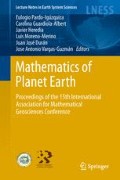Abstract
Estimates of a whole block composition may be useful for improving the assessment and mining of resources, especially if the economic viability depends on more than just one metal or component. Banded Iron Formation (BIF) represents such a case, where optimal exploitation requires evaluation of Fe content, as well as waste and penalty elements. Block cokriging of the whole composition may yield these estimates. To avoid the spurious correlation problem, this should be based on log-ratios of the composition. But due to the non-linearity of the log-ratio transformations, this does not yield a direct change-of-support model. This contribution explores the approximation of this block average compositional cokriging by means of geostatistical simulation within the block. This methodology is illustrated with a BIF deposit of Western Australia.
Access this chapter
Tax calculation will be finalised at checkout
Purchases are for personal use only
References
Griffin, A. C. (1981). Structure and iron ore deposition in the Archaean Koolyanobbing Greenstone belt, Western Australia. Geological Society of Australia, Special Publication 7, 429–438.
Angerer, T., & Hagemann, S. (2010). The BIF-hosted high-grade iron ore deposits in the Archean Koolyanobbing Greenstone Belt, Western Australia: Structural control on synorogenic- and weathering-related magnetite-, hematite- and goethite-rich iron ore. Economic Geology, 105, 917–945.
Chayes, F. (1960). On correlation between variables of constant sum. Jou. Geophys. Res., 65, 4185–4193.
Aitchison, J. (1986). The statistical analysis of compositional data. London: Chapman & Hall Ltd.
Pawlowsky-Glahn, V., & Olea, R. A. (2004). Geostatistical analysis of compositional data. New York: Oxford University Press.
Myers, D. E. (1982). Matrix formulation of co-kriging. Mathematical Geology 14, 249–257.
Tolosana-Delgado, R. (2006). Geostatistics for constrained variables: Positive data, compositions and probabilities. PhD dissertation, Girona, Spain.
Pawlowsky-Glahn, V. (1989). Cokriging of regionalized compositions. Mathematical Geology, 21, 513–521.
Author information
Authors and Affiliations
Corresponding authors
Editor information
Editors and Affiliations
Rights and permissions
Copyright information
© 2014 Springer-Verlag Berlin Heidelberg
About this paper
Cite this paper
Tolosana-Delgado, R., Mueller, U., van den Boogaart, K.G., Ward, C. (2014). Compositional Block Cokriging. In: Pardo-Igúzquiza, E., Guardiola-Albert, C., Heredia, J., Moreno-Merino, L., Durán, J., Vargas-Guzmán, J. (eds) Mathematics of Planet Earth. Lecture Notes in Earth System Sciences. Springer, Berlin, Heidelberg. https://doi.org/10.1007/978-3-642-32408-6_154
Download citation
DOI: https://doi.org/10.1007/978-3-642-32408-6_154
Published:
Publisher Name: Springer, Berlin, Heidelberg
Print ISBN: 978-3-642-32407-9
Online ISBN: 978-3-642-32408-6
eBook Packages: Earth and Environmental ScienceEarth and Environmental Science (R0)

